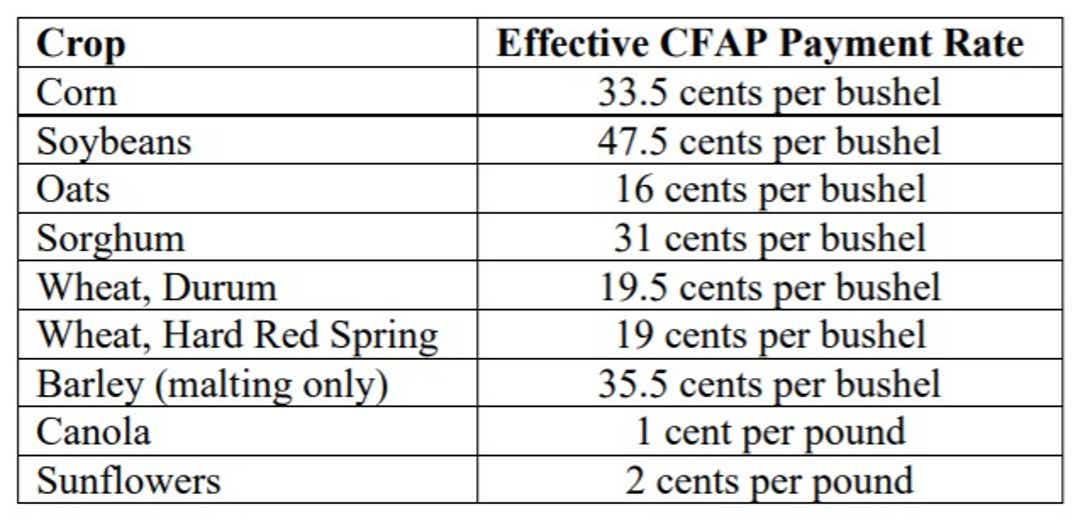
The USDA has published details on the Coronavirus Food Assistance Program (CFAP) direct payments to farmers impacted by market disruptions due to COVID-19. For commodity crops, payments focus on crops with price declines exceeding 5% from mid-January to mid-April.
The three major non-specialty crops in Wisconsin that farmers will be eligible for payments are corn, soybeans and oats. Specialty crops are also potentially eligible, but are discussed elsewhere (https://ift.tt/36GEUyw).
This article briefly explains payment calculation and encourages farmers to connect with their county USDA Farm Service Agency (FSA) office to enroll.
CFAP Payments Rates
As a confusing factor, two sources of funding were authorized by Congress and each will have different payment rates (https://ift.tt/2Mb7mz9). From a farmer’s perspective, CFAP uses the average of these two payment rates. The table below lists the final effective prices per bushel for major Wisconsin crops, plus some crops that may have a few acres in Wisconsin. These prices incorporate the averaging between the two different payment rates.

At this time, several crops are excluded from eligibility, including soft red winter wheat, hard red winter wheat, white wheat, rye, feed barley, and hemp, as are alfalfa and forage crops. Eligible crops made into silage or hay are eligible for payments after conversion to grain equivalents.
For corn silage, the grain equivalent used is 7.94 bushels per ton and 22.69 bushels per ton for corn baled as hay. For oats, the grain equivalent is 4.08 bushels per ton of silage and 11.66 bushels per ton of hay. County FSA offices will have the conversion factors used for other eligible crops used for silage or hay.
Calculating Payments
Farmers will be asked to certify their 2019 total production for eligible crops, as well as their unpriced inventories for each crop on January 15, 2020. The production to use for calculating CFAP payments for each eligible crop is the lesser of a) 50% of 2019 production and b) unpriced inventory on January 15, 2020.
The first CFAP payment will then be 80% of this production multiplied by the price from the table. Later, if funding is still available, a second CFAP payment for the remaining 20% will be made.
As an example, suppose a farm harvested 50,000 bushels of corn in 2019 and on January 15, 2020 still had 30,000 bushels in storage (they had already sold or fed 20,000 bushels). The farm also sold in November 2019 a forward contract to deliver had 10,000 bushels of corn on March 15, 2020. This corn was part of their inventory on January 15, 2020.
For this farm, half of their 2019 production is 50% × 50,000 bushels = 25,000 bushels and their unpriced inventory on January 15 was 30,000 bushels – 10,000 bushels forward contracted = 20,000 bushels. The lesser of these is the 20,000 bushels of unsold inventory, so the farm uses 20,000 bushels to calculate the CFAP payment.
For this example, the first corn CFAP payment would then be 80% × 20,000 bu × $0.335/bu = $5,360. The USDA FSA has a CFAP payment calculator available at https://bit.ly/2yKPhVH. This spreadsheet also completes and prints the necessary forms based on the information entered.
Signup Details
FSA begins taking CFAP applications on May 26, 2020 until August 28, 2020. Farmers should call their county FSA office to schedule an appointment. To prepare, farmers will need to be able to certify their 2019 production and inventory remaining on January 15 for each eligible crop.
Other information needed will be tax identification number, farm operating structure, adjusted gross income compliance certification and direct deposit information. Applications will be submitted electronically (not in person), by scanning, emailing or faxing. Please call your FSA office to set an appointment to begin your electronic application process before sending personal information.
Payment Limits
Payment limits are $250,000 per person and legal entity, applied to the total CFAP payments made for all eligible commodities, including dairy, livestock and specialty crops. Unlike other FSA programs, payment limitation rules are more stringent for corporations, LLCs and partnerships. These entities may receive up to $250,000 for each shareholder who contributes substantial labor or management (at least 400 hours of active management or labor), up to three shareholders.
Farms must also satisfy conservation compliance provisions, not have a controlled substance violation, and, if a foreign person, provide land, capital and a substantial amount of active personal labor to the farming operation.

Paul Mitchell is an Ag Economist at UW-Madison
"payment" - Google News
May 30, 2020 at 04:28AM
https://ift.tt/2ZWvbTk
Details on CFAP direct payment for commodity crops - Wisconsin State Farmer
"payment" - Google News
https://ift.tt/3bV4HFe
https://ift.tt/2VYfp89
Bagikan Berita Ini














0 Response to "Details on CFAP direct payment for commodity crops - Wisconsin State Farmer"
Post a Comment